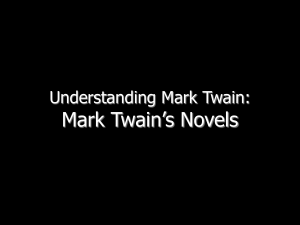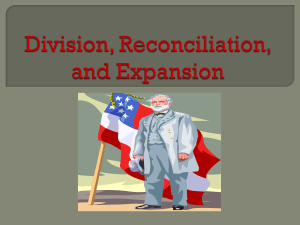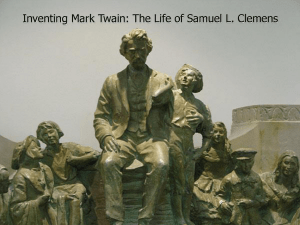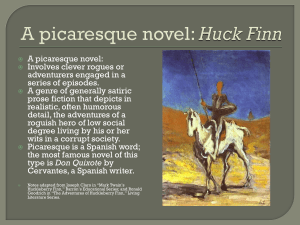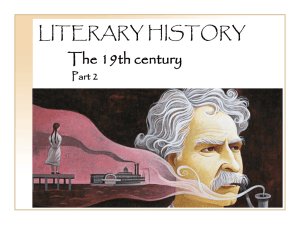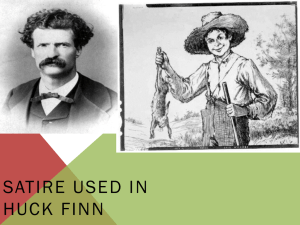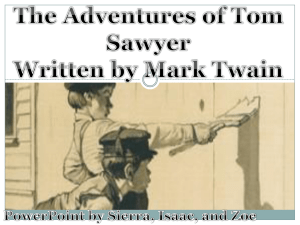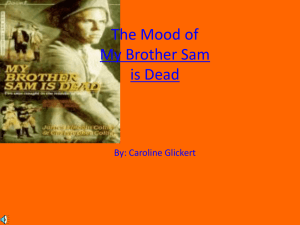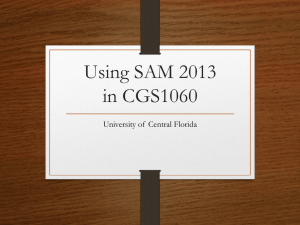Understanding Mark Twain Preview - History of Redding, Connecticut
advertisement
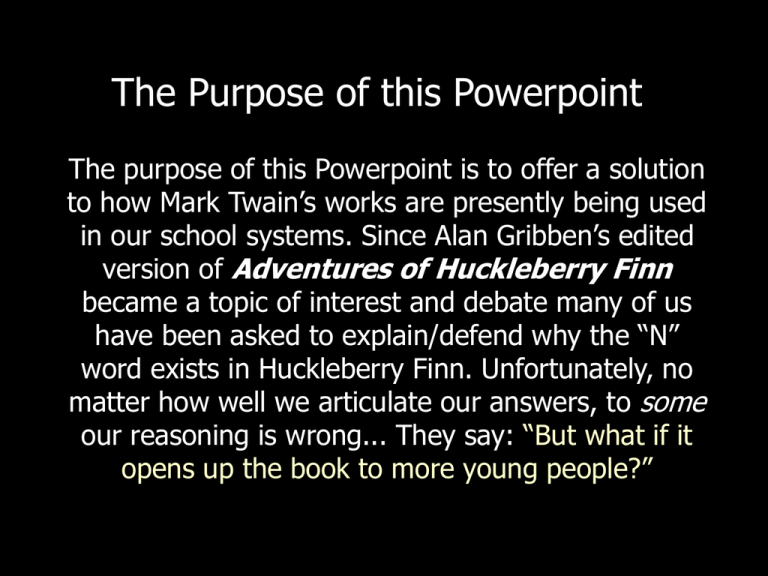
The Purpose of this Powerpoint The purpose of this Powerpoint is to offer a solution to how Mark Twain’s works are presently being used in our school systems. Since Alan Gribben’s edited version of Adventures of Huckleberry Finn became a topic of interest and debate many of us have been asked to explain/defend why the “N” word exists in Huckleberry Finn. Unfortunately, no matter how well we articulate our answers, to some our reasoning is wrong... They say: “But what if it opens up the book to more young people?” The Purpose of this Powerpoint But the truth is, even if by changing a couple words you opened up the book to millions of new readers… the whole point of the book involves the “N” word (as a hate word), the racism fueling this hatred and how it eventually dawns on Huck that this type of behavior and hatred is wrong. So by removing the “N” word you lose the impact of the hatred Twain is not only pointing out but calling out in 1885. So what’s my solution? Read on… My solution is that we don’t force children to read Mark Twain. What we do is teach them who Mark Twain was and show them the unique life experiences he had that made him who he was and fueled the novels that he wrote. Mark Twain’s life is not a hard sell, and once you’re hooked, you’re hooked. Imagine if children *wanted* to read Mark Twain and as they read Mark Twain they understood and appreciated what he was saying in those texts. That’s my solution to this “problem”. Enjoy this preview and please send me your thoughts and ideas so I can improve on it. * Much of this text comes from Twain scholars and those scholars and sources will be credited in the final version of this Powerpoint. Understanding Mark Twain: The Life of Samuel L. Clemens Sure… You could call me “Rags to Riches” Halley’s Comet Born: 11/30/1835 Florida, Missouri Died: 04/21/1910 Redding, Connecticut “I came in with Halley’s Comet in 1835. It is coming again next year (1910), and I expect to go out with it. It will be the greatest disappointment of my life if I don’t go out with Halley’s Comet.” -Mark Twain, a Biography In 1910, Halley’s Comet reached perihelion on April 20th, Twain died on the 21st. Samuel Langhorne Clemens, was born in this cabin in the small frontier settlement of Florida, Missouri. Interior of Florida, Missouri home Samuel L. Clemens was born two months premature, on November 30th 1835. He was the sixth child of John and Jane Clemens. Hearing develops more quickly in premature babies and he did exhibit an unusual ability to retain sounds, which may explain his unique gift of transforming spoken language into literature. Other Talented Premature Babies: Pablo Picasso Isaac Newton Albert Einstein Charles Darwin Renoir John Keats Franklin Roosevelt Stevie Wonder Understanding Huckleberry Finn In many ways Adventures of Huckleberry Finn is autobiographical. Twain was holding a mirror up at postCivil War America and screaming: “What we did was wrong!” Understanding Huckleberry Finn Although the Missouri he grew up in never joined the Confederacy, it was a world in which slavery was taken for granted by most whites, defended by all public institutions, including the churches; Even Sam's own parents owned slaves. Understanding Huckleberry Finn One of the slaves that influenced Sam’s life was a middle aged slave known to him as “Uncle Dan’l” He’d later recall the “privileged nights” he, his cousins & slave children clustered at Dan’l’s feet to hear him tell his thunderous stories. “He has served me well, these many, many years…spiritually I have had his welcome company… & have staged him in books as his own name and as “Jim”…It was on the farm that I got my strong liking for his race and my appreciation of… its fine qualities.” Understanding Huckleberry Finn In his Notebook #35 he writes: “In those slave-holding days the whole community was agreed as to one thing- the awful sacredness of slave property.” “It shows that that strange thing, the conscience - the unerring monitor - can be trained to approve any wild thing you want it to approve if you begin its education early & stick to it.” Understanding Huckleberry Finn In Following the Equator, he says: “When I was ten years old I saw a man fling a lump of iron-ore at a slave-man in anger, for merely doing something awkwardly- as if that were a crime. It bounded from the man’s skull, and the man fell and never spoke again. He was dead in an hour… Nobody in the village approved of that murder, but of course no one said much about it.” (Chapter 38) Understanding Huckleberry Finn This history left Sam a legacy of guilt, guilt that he tried to lessen through acts of charity. He donated money and made special appearances at fundraising events for numerous African American Churches, Institutes, and Associations. He also supported individuals, most notably Warner T. McGuinn, a struggling African American law student at Yale Law School who Sam anonymously paid tuition for. He noted: “We have ground the manhood out of them, & the shame is ours, not theirs, & we should pay for it.” Understanding Huckleberry Finn Adventures of Huckleberry Finn took Twain 8 years to write and between manuscript 1 and 2, he made more than 1,700 revisions. 88 percent of these revisions being: word changes, spelling, punctuation and adding emphasis. He used the words he used for a reason. Twain scholar Dr. Cindy Lovell said it best: “Twain pokes us with a sharp stick, makes us squirm, makes us highly uncomfortable. And it’s effective.” Twain with John T. Lewis Of this photo Twain said: “The colored man… is John T. Lewis, a friend of mine. These many years- 34 in fact. I have not known an honester man nor a more respect-worthy-one. 27 years ago, by the prompt and intelligent exercise of his courage, presence of mind and extraordinary strength, he saved the lives of 3 relatives of mine… Naturally I hold him in high and grateful regard.” In summary… I am not a Racist. Now… back to my life story. Sam’s family moved to nearby Hannibal, Missouri in 1839, where he’d enjoy his boyhood in the presence of the broad Mississippi River. Many of Twain’s characters were a product of his childhood experiences in Hannibal. “When I find a well-drawn character in fiction or biography I generally take a warm personal interest in him, for the reason that I have known him before… met him on the river.” -Mark Twain, Life on the Mississippi Location, Location, Location Hannibal was the center of America at a time when America was making the transition from East to West. Sam had a very unique, front row seat to civilization… Immigrants, Merchants, Speculators, Gamblers, Thieves, Politicians, Preachers, Runaways & Indians… he saw it all on the river front and he soaked it all in. Because of this, Sam would experience a very diverse group of individuals or as Ron Powers’ noted in Mark Twain, a Life: “…a continuing vaudeville of floating humanity.” The Great Frontier United States in 1835 Location, Location, Location The education that Sam would receive in Hannibal from the age of four to the age of seventeen would come through loud and clear in his novels: Adventures of Huckleberry Finn and The Adventures of Tom Sawyer. Of that time, he’d note: “When I was a boy everybody was poor but didn’t know it; and everybody was comfortable and did know it.” Visiting his Boyhood Home Twain’s Boyhood Home in the present day. Note the window sizes. Sam did not care much for “traditional” schooling, but he was educated, and enjoyed the teachings of William McGuffey’s “Eclectic Reader”. The Reader was a progressive learning tool that conformed to children’s cognitive strengths and drew children into an active learning process based on “conversational” teaching and “wholesome” values: patriotism, charity, honesty, hard work, and a reverence for the Christian God. Thus as Sam learned language and writing, he also learned scripture. “No reading of Mark Twain’s literature can miss the inexhaustible evidence of the Bible as a source.” –Ron Powers In the summer months, Sam was sent to his Uncle’s farm in Florida, Missouri. There he continued to interact with the Slaves and their children: “All the Negroes were friends of ours, and with those of our own age we were in effect comrades. I say, in effect, using the phrase as a modification. We were comrades, and yet not comrades; color and condition interposed a subtle line which both parties were conscious of, and which rendered complete fusion impossible.” -Mark Twain’s Autobiography In addition to his unique life experiences, Sam would also be exposed to the power of public speaking at a young age. In that timeframe, Hannibal hosted many great orators & Sam would absorb & later commander their techniques. The Role Death Played in Twain’s Life “Pity is for the living, envy is for the dead.” - Following the Equator Enduring the untimely deaths of loved ones was a theme throughout Twain’s life. It began with the death of his brother when he was 4, followed by his father when he was 11 and it would continue straight-on-up to the final year of his life when he lost his youngest daughter Jean. Jean was only 28 years old. On that day he wrote: “Possibly I know now what the soldier feels when a bullet crashes through his heart.” After the death of his Father, Sam went to work as a Printer’s Devil. A printer’s devil was an apprentice or young assistant to a printer. The Typesetter & Twain The tedious work that typesetting required revealed the importance of the right word(s). Each letter had to be selected and slid into place to form the sentences of each article. It is also very likely that the lessons learned in this vocation played a role in both his handwriting style and his manner of speech. “His speaking style, famous for its “long talk” and its effective pauses, was virtually an aural analog of typography’s orderly flow.” - Ron Power, Mark Twain, a life. Sam at 15 When he was 16 (1851), Sam began contributing humorous pieces, and occasionally stood in as Editor when his brother Orion was away. In 1852, Sam gained interest East of the Mississippi via articles in a Boston magazine and The Philadelphia Saturday Evening Post. The Dandy Frightening the Squatter Written in 1852, Sam’s humorous piece “The Dandy Frightening the Squatter” was submitted and published in a Boston magazine. “The squatter calmly surveyed him a moment, and then, drawing back a step, he planted his huge fist directly between the eyes of his astonished antagonist, who, in a moment, was floundering in the turbid waters of the Mississippi.” Invigorated by the possibilities that existed for him outside of Missouri. Sam left Hannibal in June of 1853, three weeks after his seventeenth birthday, working initially in St. Louis as a typesetter before heading to the World's Fair in New York City. Young Sam Travels to New York City The next three and half years found him moving between New York, Philadephia, Washington D.C., Muscatine (Iowa), St. Louis, Keokuk (Iowa), and Cincinnati. Sam at 18 Sam’s teenage travels… 2,000+ miles Keep in mind these travels are taking place in a time period where Airplanes and Credit Cards do not exist. To travel to these places he needed to employ multiple transportation options: steamships, stagecoaches, trains, and omnibuses and he needed to find a job (without references or help) when he got there. In February of 1857, he took passage from Cincinnati to New Orleans, with the intention of embarking on the Amazon River to seek his fortune in the then thriving coca trade. He was just twenty-one years old. His plans changed quickly when he met Riverboat pilot Horace Bixby. Sam's boyhood dream to become a steamboat pilot was revived. In April of 1861, when the Civil War caused the suspension of civilian river traffic on the Mississippi, Sam's career as a steamboat pilot came to an abrupt end. In the summer of 1861 he found himself on a stagecoach heading west with his older brother Orion, who had been appointed Secretary of the Nevada Territory. Sam’s travels by his mid-twenties Sam at 23 More to Come Soon. The next revision will explore his talents as a writer and public speaker. Your thoughts and ideas are appreciated. -Brent M. Colley bcolley@colleyweb.com http://twainproject.blogspot.com 860-294-6071 (cell number)

